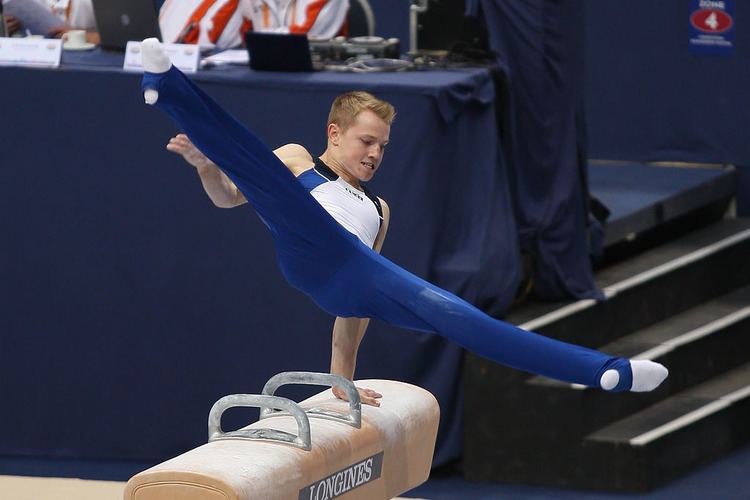 | ||
The pommel horse (also side horse) is an artistic gymnastics apparatus. Traditionally, it is used by only male gymnasts. Originally made of a metal frame with a wooden body and a leather cover, modern pommel horses have a metal body covered with foam rubber and leather, with plastic handles (or pommels).
Contents
History
The pommel horse was developed centuries ago as an artificial horse used by soldiers to practice mounting and dismounting. Alexander the Great is believed to have used two.
Dimensions
Measurements of the apparatus are published by the Fédération Internationale de Gymnastique (FIG) in the Apparatus Norms brochure.
Routines
A typical pommel horse exercise involves both single leg and double leg work. Single leg skills are generally in the form of scissors. Double leg work however, is the main staple of this event. The gymnast swings both legs in a circular motion (clockwise or counterclockwise depending on preference) and performs such skills on all parts of the apparatus. To make the exercise more challenging, gymnasts will often include variations on a typical circling skill by turning (moores and spindles), by straddling their legs (Flairs), placing one or both hands on the pommel or the leather, or moving up and down the horse placing their hands on the pommel and/or the leather (travelling). Routines end when the gymnast performs a dismount, either by swinging his body over the horse or going through a handstand to land on the mat. The pommel horse, its gymnastic elements, and various rules are all regulated by the Code of Points.
Pommel horse is considered one of the more difficult men's events. While it is well noted that all events require a certain build of muscle and technique, pommel horse tends to favor technique over muscle. This is because horse routines are done from the shoulders in a leaning motion and that no moves need to be held unlike other events. Therefore, stress induced in one's arms is reduced meaning less muscle is needed in this event than events like still rings or parallel bars.
International level routines
A pommel horse routine should contain at least one element from all element groups:
Scoring and rules
As with all events in the Fédération Internationale de Gymnastique guidelines, form is crucial to any successful routine. For pommel horse, form consists of keeping one's feet pointed and legs straight during the entire routine. The gymnast should keep his legs together during all elements, exceptions beings scissors, single legged elements, and flairs. Gymnasts are also deducted for not using all three sections of the horse and pausing or stopping on the apparatus. Deductions also apply for brushing and hitting the apparatus.
